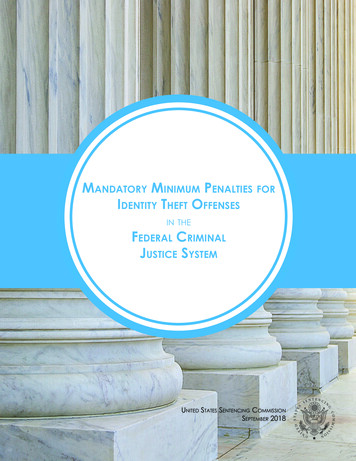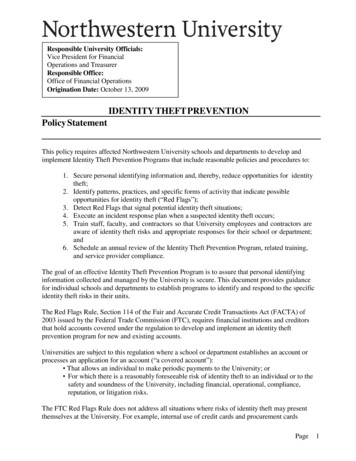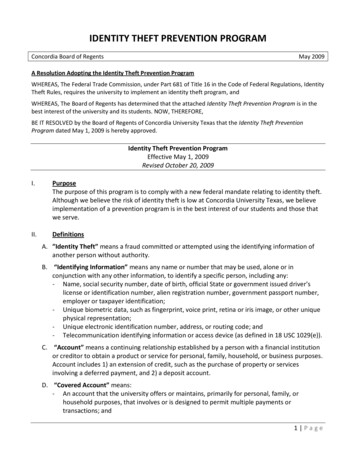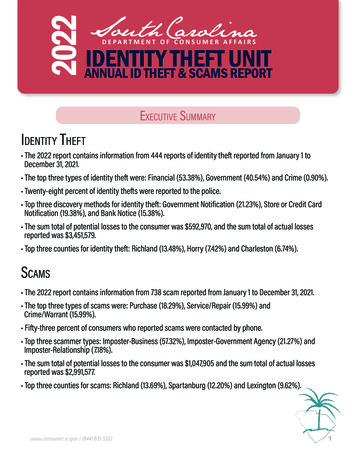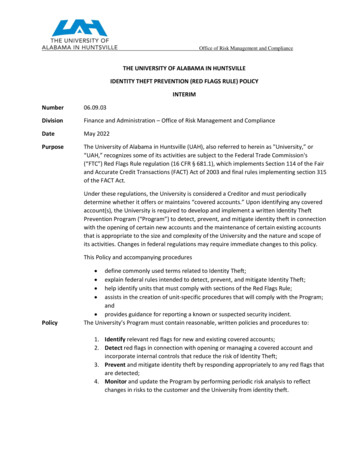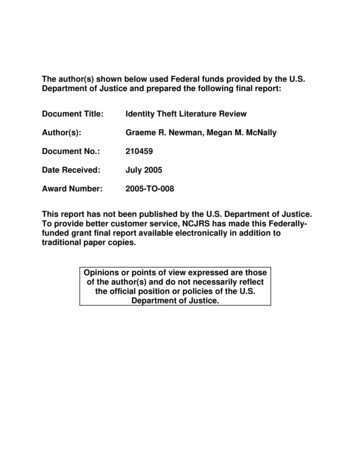
Transcription
The author(s) shown below used Federal funds provided by the U.S.Department of Justice and prepared the following final report:Document Title:Identity Theft Literature ReviewAuthor(s):Graeme R. Newman, Megan M. McNallyDocument No.:210459Date Received:July 2005Award Number:2005-TO-008This report has not been published by the U.S. Department of Justice.To provide better customer service, NCJRS has made this Federallyfunded grant final report available electronically in addition totraditional paper copies.Opinions or points of view expressed are thoseof the author(s) and do not necessarily reflectthe official position or policies of the U.S.Department of Justice.
This document is a research report submitted to the U.S. Department of Justice. This report has notbeen published by the Department. Opinions or points of view expressed are those of the author(s)and do not necessarily reflect the official position or policies of the U.S. Department of Justice.IDENTITY THEFT LITERATURE REVIEWPrepared for presentation and discussion at the National Institute of Justice Focus GroupMeeting to develop a research agenda to identify the most effective avenues of researchthat will impact on prevention, harm reduction and enforcementJanuary 27-28, 2005Graeme R. NewmanSchool of Criminal Justice, University at AlbanyMegan M. McNallySchool of Criminal Justice, Rutgers University, NewarkThis project was supported by Contract #2005-TO-008 awarded by the NationalInstitute of Justice, Office of Justice Programs, U.S. Department of Justice. Points ofview in this document are those of the author and do not necessarily represent the officialposition or policies of the U.S. Department of Justice.i
This document is a research report submitted to the U.S. Department of Justice. This report has notbeen published by the Department. Opinions or points of view expressed are those of the author(s)and do not necessarily reflect the official position or policies of the U.S. Department of Justice.CONTENTSEXECUTIVE SUMMARY . iv1. INTRODUCTION . 12. DEFINITION OF IDENTITY THEFT . 13. TYPES OF IDENTITY THEFT. 3Exploiting Weakness in Specific Technologies and Information Systems . 4Financial Scams . 4As a motive for other crimes . 4Facilitating Other Crimes . 5Avoiding Arrest. 5Repeat Victimization: “Classic” Identity Theft. 5Organized Identity Theft . 54. EXTENT AND PATTERNING OF IDENTITY THEFT . 7Sources of Data and Measurement Issues . 7Agency Data . 7Research Studies . 11Anecdotes . 13The Extent of Identity Theft. 13Distribution in the U.S. . 19Geographic patterns . 19Offense-specific patterns . 20Victims . 21Victim demographics . 22Children as victims . 22Deceased as victims . 23Institutional victims . 24The elderly as victims . 25Repeat victimization . 25Offenders. 26Offender typology. 26Organizations as offenders. 27Relationship between victims and offenders. 275. THE COST OF IDENTITY THEFT . 30Financial costs: Businesses . 31Financial costs: The criminal justice system . 32Financial costs: Individuals. 34Personal costs (non-financial) . 35Societal costs. 376. EXPLAINING IDENTITY THEFT: THE ROLE OF OPPORTUNTIY . 38Identity and its Authentication as the Targets of Theft . 39Identity as a “Hot Product” . 40Exploiting Opportunities: Techniques of Identity Theft . 43How offenders steal identities. 43How offenders use stolen identities . 46Why Do They Do It?. 46Concealment . 46Anticipated rewards . 46A note on motivation . 46NEWMAN AND McNALLYii
This document is a research report submitted to the U.S. Department of Justice. This report has notbeen published by the Department. Opinions or points of view expressed are those of the author(s)and do not necessarily reflect the official position or policies of the U.S. Department of Justice.CONTENTS (Continued)7. THE LAW ENFORCEMENT RESPONSE TO IDENTITY THEFT. 47Reporting and Recording of Identity Theft . 47Harm Reduction . 49Effective police response . 49Task Forces and Cross Jurisdictional Issues . 51State efforts to address the cross-jurisdictional issues . 52Federal efforts to address the cross-jurisdictional issues . 53Attorney General’s Council on White Collar CrimeSubcommittee on Identity Theft . 54The Know Fraud initiative . 54The FTC’s Efforts . 54Investigation and Prosecution . 56State investigation and prosecution. 57Federal investigation and prosecution. 60Sentencing and Corrections . 658. LEGISLATION. 63State legislation . 63Federal legislation . 659. PREVENTION. 68Reducing Opportunity. 68Techniques to reduce identity theft . 69The Role of Technology and the “Arms Race”. 7110. CONCLUSIONS AND RECOMMENDATIONS . 73REFERENCES . 79APPENDIX 1: Descriptions of Identity Theft Data Sources. 88APPENDIX 2: Summary of FTC Consumer Sentinel/Identity TheftClearinghouse Data. 91APPENDIX 3: Summary of Federal Identity Theft-RelatedStatutes and State Identity Theft Laws. 93APPENDIX 4: Cases of Identity Theft. 97APPENDIX 5: Web pages returned by Google Search on 10/8/04. 103iii
This document is a research report submitted to the U.S. Department of Justice. This report has notbeen published by the Department. Opinions or points of view expressed are those of the author(s)and do not necessarily reflect the official position or policies of the U.S. Department of Justice.EXECUTIVE SUMMARYThis review draws on available scientific studies and a variety of other sources to assesswhat we know about identity theft and what might be done to further the research base ofidentity theft.Until the federal Identity Theft and Assumption Deterrence Act of 1998, there was noaccepted definition of identity theft. This statute defined identity theft very broadly andmade it much easier for prosecutors to conduct their cases. However, it was of little helpto researchers, because a closer examination of the problem revealed that identity theftwas composed of a number of disparate kinds of crimes committed in widely varyingvenues and circumstances.The majority of States have now passed identity theft legislation, and the generic crime ofidentity theft has become a major issue of concern. The publicity of many severe cases inthe print and electronic media and the portrayal of the risk of identity theft in a number ofeffective television commercials have made identity theft a crime that is now widelyrecognized by the American public.The Internet has played a major role in disseminating information about identity theft,both in terms of risks and information on how individuals may avoid victimization. It hasalso been identified as a major contributor to identity theft because of the environment ofanonymity and the opportunities it provides offenders or would-be offenders to obtainbasic components of other persons’ identities.The biggest impediment to conducting scientific research on identity theft andinterpreting its findings has been the difficulty in precisely defining it. This is because aconsiderable number of different crimes may often include the use or abuse of another’sidentity or identity related factors. Such crimes may include check fraud, plastic cardfraud (credit cards, check cards, debit cards, phone cards etc.), immigration fraud,counterfeiting, forgery, terrorism using false or stolen identities, theft of various kinds(pick pocketing, robbery, burglary or mugging to obtain the victim’s personalinformation), postal fraud, and many others.Extent and Patterning of Identity TheftThe best available estimates of the extent and distribution of identity theft are providedby the FTC (Federal Trade Commission) from its victimization surveys and from itsdatabase of consumer complaints. The most recent estimate, produced by a studymodeled after the FTC's original 2003 methodology, suggests that 9.3 million adults hadbeen victimized by some form of identity theft in 2004 (BBB 2005), which may representa leveling off from the FTC's previous finding of 9.91 million in 2003 (Synovate 2003).While there are some differences in the amount of identity theft according to states andregions and to some extent age, the data available suggest that, depending on the type ofidentity theft, all persons, regardless of social or economic background are potentiallyNEWMAN AND McNALLYiv
This document is a research report submitted to the U.S. Department of Justice. This report has notbeen published by the Department. Opinions or points of view expressed are those of the author(s)and do not necessarily reflect the official position or policies of the U.S. Department of Justice.vulnerable to identity theft. This observation applies especially to those types of identitytheft that occur when an offender steals a complete database of credit card informationfor example. However, there is some evidence that individuals are victimized by thosewho have easy access to their personal information, which may include family membersand relatives (access to dates of birth, mother’s maiden name, social security number etc.)or those with whom the victim lives in close contact: college dorms or military barracks,for example.Types and stages of Identity TheftDepending on the definition of identity theft, the most common type of identity theft iscredit card fraud of various kinds and there is evidence that the extent of credit card fraudon the internet (and by telephone) has increased because of the opportunities provided bythe Internet environment. However, some prefer not to include credit card fraud as “true”identity theft, since it may occur only once, and be discovered quickly by the credit cardissuing company, often before even the individual card holder knows it. Other types ofidentity theft such as account takeover are more involved and take a longer time tocomplete.Three stages of identity theft have been identified. A particular crime of identity theftmay include one or all of these stages.Stage 1: Acquisition of the identity through theft, computer hacking, fraud, trickery,force, re-directing or intercepting mail, or even by legal means (e.g. purchase informationon the Internet).Stage 2: Use of the identity for financial gain (the most common motivation) or to avoidarrest or otherwise hide one’s identity from law enforcement or other authorities (such asbill collectors). Crimes in this stage may include account takeover, opening of newaccounts, extensive use of debit or credit card, sale of the identity information on thestreet or black market, acquisition (“breeding”) of additional identity related documentssuch as driver’s license, passport, visas, health cards etc.), filing tax returns for largerefunds, insurance fraud, stealing rental cars, and many more.Stage 3: Discovery. While many misuses of credit cards are discovered quickly, the“classic” identity theft involves a long period of time to discovery, typically from 6months to as long as several years. Evidence suggests that the time it takes to discovery isrelated to the amount of loss incurred by the victim. At this point the criminal justicesystem may or may not be involved and it is here that considerable research is needed.The recording and reporting of identity theftAccording to the FTC research, there are differences in the extent to which individualsreport their victimization (older persons and the less educated are likely to take longer toreport the crime and are less likely to report the crime at all). It also suggests that thelonger it takes to discovery, and therefore reporting of the crime to the relevant authority,EXECUTIVE SUMMARYv
This document is a research report submitted to the U.S. Department of Justice. This report has notbeen published by the Department. Opinions or points of view expressed are those of the author(s)and do not necessarily reflect the official position or policies of the U.S. Department of Justice.the greater the loss and suffering of the victim, and from the criminal justice perspective,the poorer the chance of successful disposal of the case.However, in contrast to the FTC’s extensive database of consumer complaints andvictimization, the criminal justice system lacks any such information. There is nonational database recorded by any criminal justice agency concerning the number ofidentity theft cases reported to it, or those disposed of by arrest and subsequentlyprosecution. The FBI and the US Secret Service have reported numbers of cases ofidentity theft in recent years, but these number in the hundreds and without state, multiagency and local level data, there is at present no way to determine the amount of identitytheft confronted by the criminal justice system.The recording and reporting of identity theft as a crime by criminal justice authorities,especially local police has been thwarted by three significant issues:1. The difficulty of defining identity theft because of its extensive involvement inother crimes. Most police departments lack any established mechanism to recordidentity theft related incidents as separate crimes. This is exacerbated by the lackof training of police officers to identify and record information concerning regularcrimes that also involve identity theft.2. The cross-jurisdictional character of identity theft which over the course of itscommission may span many jurisdictions that may be geographically far apart.This has led to jurisdictional confusion as to whose responsibility it is to recordthe crime. Although efforts have been made by the IACP to resolve this issue,there are still significant hurdles to be over come.3. Depending on the type of identity theft, individuals are more likely to report theirvictimization to other agencies instead of the police, such as their bank, creditcard issuing agency etc. Thus, there is a genuine issue as to the extent to whichpolice are the appropriate agency to deal with this type of victimization, when infact it is the many financial agencies that are in a position to attend to the victim’sproblems and even to investigate the crimes (which many do). Therefore there isstrong motivation for police agencies to avoid taking on the added responsibilityfor dealing with this crime.Researching Identity Theft OffendingAlthough the different component behaviors of identity theft and its related crimes havebeen known for many years, identity theft is viewed primarily as a product of theinformation age, just as car theft was a product of the industrial age of mass production.Thus, the emphasis on research should be on uncovering the opportunity structure ofidentity theft. This requires two important steps:1. breaking identity theft down into carefully defined specific acts or sequences ofbehaviors, and2. identifying the opportunities provided offenders by the new environment of theinformation age.NEWMAN AND McNALLYvi
This document is a research report submitted to the U.S. Department of Justice. This report has notbeen published by the Department. Opinions or points of view expressed are those of the author(s)and do not necessarily reflect the official position or policies of the U.S. Department of Justice.While considerable research based on case studies has identified the criminogenicelements of the Internet as the prime leader of the information age, there is littleinformation gained directly from offenders as to how exactly they carry out their crimes,and how they identify opportunities for their commission. It is recommended, thereforethat studies that interview offenders and their investigators to develop a scripting of thesequences of behaviors and decisions that offenders take in the course of their crimes isessential for developing effective intervention techniques. This approach also will lead toinsights as to future ways in which offenders may exploit and identify weaknesses in theinformation environment. Something like an “arms race” is involved between offendersand those trying to thwart them. System interventions and improvements in technologycan work wonders for prevention (e.g., passwords for credit cards), but in little time,offenders develop techniques to overcome these defenses.Researching Identity Theft PreventionThe research focus recommended is based generally on the situational crime preventionliterature and research. This requires the direct involvement of agencies and organizationsin addition to, and sometimes instead of, criminal justice involvement. Local police, forexample, can do little to affect the national marketing practices of credit card issuingcompanies that send out mass mailings of convenience checks. Here, interventions at ahigh policy level are needed, following the lines of a successful program instituted in theU.K. by the Home Office to reduce credit card fraud in the 1990s. However, thestrategies and roles of government intervention in business practices -- whether bycriminal justice agencies or other government agencies – are highly complex andnecessitate serious research on their own. Experience in other spheres such as trafficsafety, car safety and car security and environmental pollution could be brought to bear indeveloping a strategy for the programmatic reduction of identity theft that involvesgovernment agencies and businesses working together.At a local level, research is needed to examine ways to develop programs of prevention inthree main areas of vulnerability to identity theft. These are:1. the practices and operating environments of document issuing agencies (e.g.departments of motor vehicles, credit card issuing companies) that allowoffenders to exploit opportunities to obtain identity documents of others, as inStage 1 of identity theft outlined above;2. the practices and operating environments of document authenticating agenciesthat allow offenders to exploit opportunities to use the identities of others eitherfor financial gain or to avoid arrest, or retain anonymity and3. the structure and operations of the information systems which generally conditionthe operational procedures of the agencies in (1) and (2).Because the certification of an identity depends on two basic criteria: the uniquebiological features of that individual (DNA, thumb print etc.) and attachment to thosedistinct features a history that certifies that the person is who s/he says s/he is. ThoughEXECUTIVE SUMMARYvii
This document is a research report submitted to the U.S. Department of Justice. This report has notbeen published by the Department. Opinions or points of view expressed are those of the author(s)and do not necessarily reflect the official position or policies of the U.S. Department of Justice.the former is relatively easy, especially with modern technologies now available, thelinking of it to an individual’s history (i.e. date and place of birth, marriage, driver’slicense, parent’s names etc.) depends on information that accumulates through anindividual’s life. Thus, the importance of maintaining careful and secure records of suchinformation both by the individual and by agencies that issue them is essential to securean identity. It is essential that agencies issuing documentation have in place a systematicand well tried system of establishing an applicant’s identity (i.e. past history) beforeissuing an additional document of identification.The twin processes of establishing an identity (e.g. issuing a birth certificate) andauthenticating an identity (e.g. accepting a credit card at point of sale) are inherentlyvulnerable to attack for a number of reasons: Old technologies that do not prevent tampering with cards and documents. These areapparent in many departments of motor vehicles across the USA, and the inadequacyof credit cards, though gradually improved over recent years, still fall far short what istechnologically possible; Lack of a universally accepted and secure form of ID. While the social security numberis universal, is well known that it is not secure. Drivers’ licenses are becoming auniversal ID by default, but their technological sophistication and procedures forissuing them vary widely from State to State; Authentication procedures that depend on employees or staff to make decisions aboutidentity. Employees with access to identity related databases may be coerced or bribedor otherwise divulge this information to identity thieves. Many may also lack trainingin documentation authentication. The availability of information and procedures for obtaining the identities of others.These include, for example the availability of personal information on the Internet freeand for sale (e.g. social security numbers), identity card making machines of the samequality of agencies that issue legitimate identity cards, and hacking programs tointercept and break into databases. The ease with which electronic databases of personal information can be moved fromone place to another on the Internet, creates the opportunity for hackers (or thoseobtaining password information from dishonest employees) to steal, hide and sell thenumbers on the black market.The research literature from situational crime prevention on various types of crime (e.g.shoplifting, theft from cars, check fraud) suggests a range of possible interventions thatcould be applied to counteract many of the above vulnerabilities. Research on adaptingspecific interventions in regard to specific modes of identity theft should thereforeprovide significant indications for effective prevention.Researching Harm and its ReductionIdentity theft involves, at a minimum two victims: the individual whose identity is stolenand, in most cases, the financial institution that is duped by the use of the victim’s stolenidentity.NEWMAN AND McNALLYviii
This document is a research report submitted to the U.S. Department of Justice. This report has notbeen published by the Department. Opinions or points of view expressed are those of the author(s)and do not necessarily reflect the official position or policies of the U.S. Department of Justice.The issue of reducing harm to individual victims has received much attention in recentyears. Congressional hearings and some limited studies of interviews with victims, haveexposed the psychological as well as financial suffering of individual victims. The focushas been on local police responses to identity theft which were originally conditioned bytheir perception that individuals were not the true victims, but that the banks were.Victims had great difficulty in obtaining police reports (as noted above, also caused bycross-jurisdictional problems) and so, without such a report, had great difficultyconvincing banks and credit reporting agencies that their identities had been stolen. Stepshave been taken by the IACP and other organizations to inform local police about the truesuffering of identity theft victims and to introduce reporting and recording rules that willhelp victims get their police reports. The extent to which this enlightened approach hasfiltered down to the local police level is yet to be determined and itself is in need ofresearch. In fact, we have extremely little knowledge of what local police departmentsactually do in response to individuals who report their victimization,There is no systematic information concerning how individual victims fare in theprosecution and disposition of their cases, though we do know that federal, state andmulti-agency task forces have cut-off levels for acceptance of cases according to financialloss, time to discovery, and whether there is an organized group involved. We guess thatthe FBI and US Secret Service between them processed a few thousand cases of identitytheft last year. If we guess that there have been similar numbers of cases proce
identity theft, since it may occur only once, and be discovered quickly by the credit card issuing company, often before even the individual card holder knows it. Other types of identity theft such as account takeover are more involved and take a longer time to complete. Three stages of identity theft have been identified.

